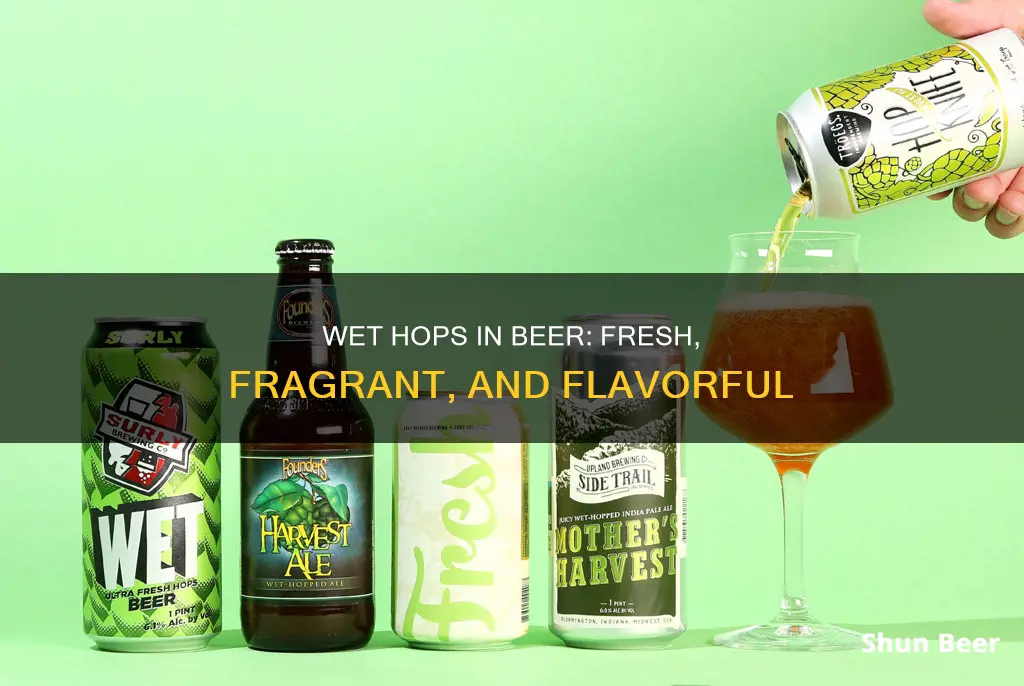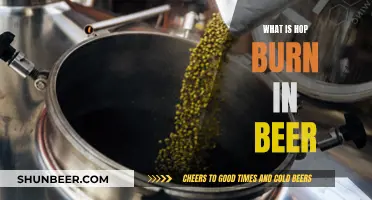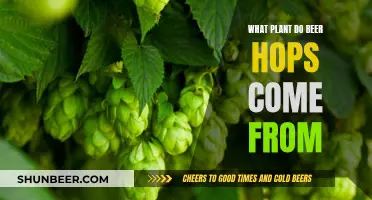
Wet hopping, also known as fresh hopping, involves adding freshly harvested hops to beer during the brewing process. Unlike hops that have been dried and turned into pellets, wet hops retain their fragile compounds, which add depth to the aroma and flavour of the beer. Wet hops are used within 48 hours of being picked, as they begin to rot due to their high water content. Wet-hopped beers are often released in the fall to celebrate the hop harvest.
What You'll Learn

Wet hops are never dried
Wet hops are used during the hop harvest season, which is typically from late summer to early fall. The hops are added to the brewing process on the same day that they are harvested. They are used throughout the brewing process, and can be added at any point.
Wet hops are used to create a unique flavour profile and aroma. This is because they contain essential oils that are lost during the drying process. Wet hops are said to impart a "super green", chlorophyll-like aroma and flavour to the finished beer. Vinnie Cilurzo of Russian River Brewing notes that wet hops produce "more fresh aromas and flavours", with "more melon and grassy notes".
Wet hops are not dried, and are therefore distinct from "fresh hops", which are kiln-dried and used as whole cones during the brewing process. Wet hops are also distinct from "dry hopping", which is a brewing technique where hops are added to the beer after fermentation to extract alpha acids and boost aroma without enhancing bitterness.
Smash Beer Recipes: Choosing the Right Hops for Your Brew
You may want to see also

Fresh hops vs wet hops
Wet hops and fresh hops are often used interchangeably, but there are some differences between the two. Wet hops are hops that are never dried and are used in brewing on the same day they are harvested. Fresh hops, on the other hand, can be used to refer to hops that are used right out of the oast house, or they can be kiln-dried and used as whole cones during the brewing process.
Wet hops are highly perishable and need to be used within a day or two of picking. They contain about 80% water, so brewers will need to use more wet hops compared to dry hops. Wet hops also take up more room in the kettle and add water that needs to be considered when calculating original and final gravities.
Fresh hops, on the other hand, can be kiln-dried and used as whole cones, or they can be dried and shaped into small pellets. These dried hops have a longer shelf life than wet hops, with the pellets remaining usable for up to three years, and the whole cones staying fresh for about a year.
Both wet hops and fresh hops can impart unique flavours and aromas to beer. Wet hops can provide more fresh aromas and flavours, with notes of melon and grass. Fresh hops, on the other hand, can give beers a grassy, plant-like, or "green" flavour profile without the bitterness associated with beers that use dried hops.
While wet hops and fresh hops have their own distinct characteristics, both can be used to create delicious and unique beers. Brewers may choose to use one or the other, or a combination of both, depending on the desired flavour profile and the availability of fresh hops.
Exploring the Hops in Your Beer: Gallon Edition
You may want to see also

Wet hops are used within 48 hours of picking
Wet hops are hops that are used within 48 hours of being picked. They are freshly cut hops, used immediately, or else they spoil. Wet hops are never dried—they are used in their natural form, straight from the hop harvest. This usually takes place in late summer to early fall, and the hops are rushed straight from the fields to breweries.
Wet hops are used on the same day they are picked, and brewers will often begin the brewing process before the hops arrive. The hops are then tossed straight into the boil to maintain their freshness. This is a delicate process, as wet hops will deteriorate within a couple of days if left unused.
Wet hops are used to create a unique flavour profile and aroma. This is because they still contain all their fine essential oils, which are lost during the drying process. Wet hops have more fresh aromas and flavours, with more grassy and melon notes. They also have a super green, chlorophyll-like aroma and flavour.
Wet hops contain about 80% water, so more hops are needed by weight than with dry hops. Four to six times as many wet hops are needed compared to dry hops. Wet hops also take up more room in the kettle, and brewers may need to reduce batch size depending on the overall hop amount and the size of the system.
Micolob Beer's Hoppy Secret: What's Inside?
You may want to see also

Wet hops are used throughout the brewing process
Wet hopping is the process of using freshly harvested hops throughout the brewing process. The hops are added to the beer on the same day they are picked, usually within 24 to 48 hours, as they will spoil and begin to rot if left unused. This is because wet hops contain about 80% water, so brewers must use more wet hops than they would with dry hops. In general, four to six times as many wet hops are needed by weight as dry hops.
Wet hops are used at any point during the brewing process. They can be added as a boil addition, whirlpool addition, dry hopping, or even in the mash. Wet hops are never dried, which means they retain their fine essential oils that would otherwise be lost during the drying process. This results in a unique flavour profile and aroma, with more fresh aromas and flavours. Vinnie Cilurzo of Russian River Brewing noted that "you get more fresh aromas and flavours when the product is wet, and it takes more, as you have to compensate for the water that is still in the hops".
Wet hops are also called fresh hops, and they are used to create fresh hop beers or wet hop beers. These beers are brewed during and shortly after the harvest season, which usually falls between late August and September. They have a short shelf life and are known for their fresh, green aromas. The hops are boiled very quickly after harvesting, which is why whole-cone hops are usually used for this technique.
Brewers analyse the moisture level of hop cones by picking them off the bine, rubbing them between their hands to warm and break them, and then sniffing them. After brushing off the plant matter, a sticky yellow residue remains. These cones have high levels of acids, oils, and aromatics, which impart unique flavour profiles to the beer as it's being brewed.
Wet hopping is not to be confused with dry hopping, which is a brewing term for adding hops late in the brewing process, either during fermentation or conditioning. Dry hopping is usually done to add more aroma and flavour without enhancing bitterness.
Malt, Hops, and Cider: What's in Your Beer?
You may want to see also

Wet hops produce a unique flavour and aroma
Vinnie Cilurzo of Russian River Brewing notes that wet hops produce more fresh aromas and flavours, with more melon and grassy notes. Wet hops also contain about 80% water, so brewers need to use more of them than dry hops. This can be challenging due to the speed at which wet hops spoil.
The late Michael Jackson described Sierra Nevada's Northern Hemisphere Harvest Ale, one of the most influential commercial wet-hopped beers in the US in 1996, as having:
> "the lightest touch of malty sweetness to start; then a surge of cleansing, refreshing, resiny, almost orange-zest flavours; and finally, an astonishingly late, long finish of fresh, appetite-arousing bitterness."
Wet hops are only available during the hop harvest season, usually from late August to September, so wet-hopped beers are a once-a-year treat. They are also more delicate than dry hops, deteriorating within a couple of days if left unused. This makes them more difficult to transport and store, but the extra effort is worth it for the unique, fresh flavour and aroma they impart.
Brewers who want to preserve the oils in the hops should add wet hops towards the end of the boil, at flameout, or during the whirlpool. This technique helps to maintain the fresh, green aromas and flavours that are characteristic of wet-hopped beers.
The Evolution of Tropical Hops in Beer
You may want to see also
Frequently asked questions
Wet hops are freshly cut hops that are used in the beer-making process within 48 hours of being picked. They are used in their natural form, without being dried and turned into pellets.
Dry hops are hops that have been dried and often turned into pellets so that they can be used throughout the year. Wet hops, on the other hand, are fresh and undried, and are only available during the hop harvest season, typically from late August to September.
Wet hops are said to impart a super green, chlorophyll-like aroma and flavour to the finished beer. They also add more intense, intricate, and fresher flavours and aromas as compared to dry hops.







